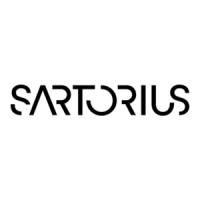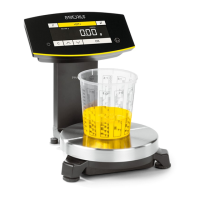Operating Instructions EVO1S1 | SPO1S1 21
Operation
Danger of scale damage!
Never close a paint can using a hammer while it is still on the weighing pan.
t When closing the paint can, place it on a firm, stable surface.
6.6 Applications
6.6.1 Calculation by a Factor
This function enables you to weigh in amounts that are smaller or larger than that of
your basic formula for a specific paint color (e. g. 250 ml of a 1 l formula).
The factors (amounts) can be set via the factor key $ and O / P in a range of 0.1
to 6.0.
The following factors can be set directly via the factor key $:
0.25 0.5 0.75 1.0 1.5 2.0 2.5 3.0 3.5 4.0 4.5 5.0.
Using the keys O (up) and P (down), the factor can be changed
− in the range 0.10 to 1.0 in increments of 0.01
− in the range 1.0 to 6.0 in increments of 0.1
Factor calculation example
As you add the components of your formula, the weight is displayed in “g.”
Let’s suppose you want to weigh 250 ml for a basic formula that has a total of 1 l,
and you don’t want to have to manually recalculate the individual components of
the formula.
The basic formula for 1 liter:
250 g 1st component
+ 250 g 2nd component
+ 500 g 3rd component
Total: 1000 g
t Place the empty container on the weighing pan.
t Briefly press the 0 key to tare.
t Press the factor key $ several times until the factor “.25” is displayed below the
factor key.
t Slowly add the first component “250 g” until the display shows “250 g.”
t Add the second component “250 g” until the display shows “500 g.”
t Add the third component “500 g” until the display shows “1000 g.”
This concludes the recalculation example. According to the display, exactly 1000 g
was poured in, but the paint can actually contains 250 g by weight in accordance
with the factor you selected.
The procedure is the same for any other conversion factor.
0.0
250.0
500.0
1000.0
.25
.25
.25
.25

